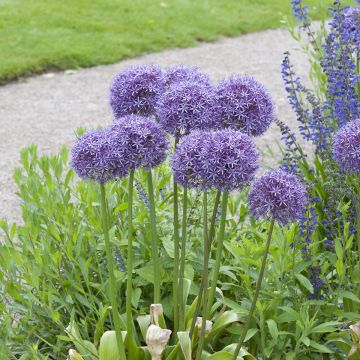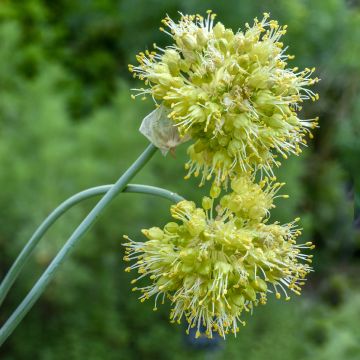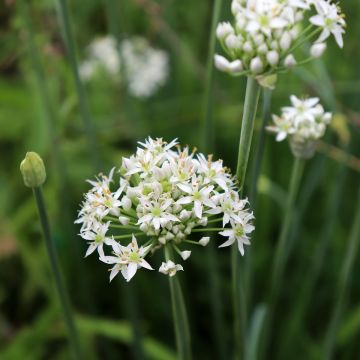Shipping country and language
Your country of residence may be:
Your country of residence is:
For a better user experience on our website, you can select:
Your shipping country:
Andorra
Austria
Belgium
Bulgaria
Canada
Chile
Croatia
Cyprus
Czechia
Denmark
Estonia
Finland
France
Germany
Greece
Hungary
Iceland
Ireland
Italy
Latvia
Lithuania
Luxembourg
Malta
Monaco
Netherlands
Poland
Portugal
Romania
Slovakia
Slovenia
Spain
Sweden
Switzerland
United Kingdom
We only deliver seed and bulb products to your country. If you add other products to your basket, they cannot be shipped.
Language:
French
German
Spanish
English
My Account
Hello
My wish lists
Plantfit
Log in / Register
Existing customer?
New customer?
Create an account to track your orders, access our customer service and, if you wish, make the most of our upcoming offers.


Ail d'ornement - Nectaroscordum tripedale
Allium tripedale
Allium tripedale
Three-cornered leek, Three-cornered garlic, Ornamental Onion
It begins its flowering, which promises to be superb!
Daniele, 17/05/2023
Order in the next for dispatch today!
Dispatch by letter from €3.90.
Delivery charge from €5.90 Oversize package delivery charge from €6.90.
More information
This item is not available in your country.
Schedule delivery date,
and select date in basket
This plant carries a 6 months recovery warranty
More information
We guarantee the quality of our plants for a full growing cycle, and will replace at our expense any plant that fails to recover under normal climatic and planting conditions.
From €5.90 for pickup delivery and €6.90 for home delivery
Express home delivery from €8.90.
Does this plant fit my garden?
Set up your Plantfit profile →
Description
Allium tripedale (syn. Nectaroscordum tripedale) is a close relative of Nectaroscordum siculum subsp. bulgaricum, from which it differs by a denser and even more decorative umbel of flowers, which will bear more and larger bell-shaped pink flowers. This spectacular flowering takes place in late spring or early summer, and remains decorative for several weeks. Still difficult to find in horticultural trade, this magnificent Caucasian species is however no more difficult to grow than an ornamental garlic. A sunny to semi-shaded exposure, and especially well-drained soil, are the keys to successfully growing this quite fantastic bulbous plant.
Allium tripedale belongs to the Amaryllidaceae family. This botanical species originates from Armenia and a vast area covering Iraq, Turkey, and northern Iran. The plant grows from a bulb and its alliaceous-scented foliage emerges from the ground in late winter. Flowering takes place in May-June. The inflorescence forms at the end of a solid and cylindrical stem measuring 90cm (35in) to 1.3m (4ft) in height, initially resembling a large bud covered with a papyraceous whitish envelope. The bud opens to release an umbel in the shape of an umbrella, sometimes irregular in shape, reaching about 10cm (4in) in diameter. This umbel is composed of 20 to 30 pendulous bell-shaped flowers, 2cm (1in) in diameter, which gradually open over a period of 5 to 6 weeks. The petals are iridescent, ranging from white to pale-pink, striped with fuchsia-pink. The flowers open to reveal their green throat adorned with stamens. They are nectariferous and highly sought after by bees and other pollinating insects. The foliage, arranged close to the ground, is composed of linear green leaves. It usually turns brown and dries out before flowering. The fruits are conical and brown, and are erect on pedicels. It produces very few daughter bulbs and mainly reproduces by sowing. The seedlings will flower after 6 years.
A superb, frost-resistant novelty for our gardens. It appreciates sunny to slightly shaded environments and well-drained soils that remain slightly moist throughout its growth and flowering period. A drier soil in summer is well tolerated. It is a fairly accommodating bulb that thrives on the edge of woodlands, in a bed, or rockery. It is best planted in groups of 5 for a beautiful effect, and pairs perfectly with late tulips in white, pink, red, or mauve. Foxgloves and penstemons will cover its absence in summer.
Plant habit
Flowering
Foliage
Botanical data
Allium
tripedale
Alliaceae - Liliaceae
Three-cornered leek, Three-cornered garlic, Ornamental Onion
Nectaroscordum tripedale
Caucasus
Other Allium
Planting and care
It is an easy-to-grow plant in well-drained soil, which should remain moist during the growth and flowering period. Plant preferably before the end of October so it has enough time to establish. It dislikes stagnant moisture in winter, as well as in summer (dry soil in summer is generally well tolerated). Give it a sunny spot in well-drained, sandy, or even rocky soil. For larger bulbs, plant at a depth of 10 or 15cm (4 or 6in), with a spacing of 15cm (6in). Plant smaller bulbs at a depth of 10cm (4in), with a spacing of 7cm (3in). Slightly rich soil will promote spectacular flowering.
Planting period
Intended location
Care
- , onOrder confirmed
Reply from on Promesse de fleurs
Haven't found what you were looking for?
Hardiness is the lowest winter temperature a plant can endure without suffering serious damage or even dying. However, hardiness is affected by location (a sheltered area, such as a patio), protection (winter cover) and soil type (hardiness is improved by well-drained soil).

Photo Sharing Terms & Conditions
In order to encourage gardeners to interact and share their experiences, Promesse de fleurs offers various media enabling content to be uploaded onto its Site - in particular via the ‘Photo sharing’ module.
The User agrees to refrain from:
- Posting any content that is illegal, prejudicial, insulting, racist, inciteful to hatred, revisionist, contrary to public decency, that infringes on privacy or on the privacy rights of third parties, in particular the publicity rights of persons and goods, intellectual property rights, or the right to privacy.
- Submitting content on behalf of a third party;
- Impersonate the identity of a third party and/or publish any personal information about a third party;
In general, the User undertakes to refrain from any unethical behaviour.
All Content (in particular text, comments, files, images, photos, videos, creative works, etc.), which may be subject to property or intellectual property rights, image or other private rights, shall remain the property of the User, subject to the limited rights granted by the terms of the licence granted by Promesse de fleurs as stated below. Users are at liberty to publish or not to publish such Content on the Site, notably via the ‘Photo Sharing’ facility, and accept that this Content shall be made public and freely accessible, notably on the Internet.
Users further acknowledge, undertake to have ,and guarantee that they hold all necessary rights and permissions to publish such material on the Site, in particular with regard to the legislation in force pertaining to any privacy, property, intellectual property, image, or contractual rights, or rights of any other nature. By publishing such Content on the Site, Users acknowledge accepting full liability as publishers of the Content within the meaning of the law, and grant Promesse de fleurs, free of charge, an inclusive, worldwide licence for the said Content for the entire duration of its publication, including all reproduction, representation, up/downloading, displaying, performing, transmission, and storage rights.
Users also grant permission for their name to be linked to the Content and accept that this link may not always be made available.
By engaging in posting material, Users consent to their Content becoming automatically accessible on the Internet, in particular on other sites and/or blogs and/or web pages of the Promesse de fleurs site, including in particular social pages and the Promesse de fleurs catalogue.
Users may secure the removal of entrusted content free of charge by issuing a simple request via our contact form.
The flowering period indicated on our website applies to countries and regions located in USDA zone 8 (France, the United Kingdom, Ireland, the Netherlands, etc.)
It will vary according to where you live:
- In zones 9 to 10 (Italy, Spain, Greece, etc.), flowering will occur about 2 to 4 weeks earlier.
- In zones 6 to 7 (Germany, Poland, Slovenia, and lower mountainous regions), flowering will be delayed by 2 to 3 weeks.
- In zone 5 (Central Europe, Scandinavia), blooming will be delayed by 3 to 5 weeks.
In temperate climates, pruning of spring-flowering shrubs (forsythia, spireas, etc.) should be done just after flowering.
Pruning of summer-flowering shrubs (Indian Lilac, Perovskia, etc.) can be done in winter or spring.
In cold regions as well as with frost-sensitive plants, avoid pruning too early when severe frosts may still occur.
The planting period indicated on our website applies to countries and regions located in USDA zone 8 (France, United Kingdom, Ireland, Netherlands).
It will vary according to where you live:
- In Mediterranean zones (Marseille, Madrid, Milan, etc.), autumn and winter are the best planting periods.
- In continental zones (Strasbourg, Munich, Vienna, etc.), delay planting by 2 to 3 weeks in spring and bring it forward by 2 to 4 weeks in autumn.
- In mountainous regions (the Alps, Pyrenees, Carpathians, etc.), it is best to plant in late spring (May-June) or late summer (August-September).
The harvesting period indicated on our website applies to countries and regions in USDA zone 8 (France, England, Ireland, the Netherlands).
In colder areas (Scandinavia, Poland, Austria...) fruit and vegetable harvests are likely to be delayed by 3-4 weeks.
In warmer areas (Italy, Spain, Greece, etc.), harvesting will probably take place earlier, depending on weather conditions.
The sowing periods indicated on our website apply to countries and regions within USDA Zone 8 (France, UK, Ireland, Netherlands).
In colder areas (Scandinavia, Poland, Austria...), delay any outdoor sowing by 3-4 weeks, or sow under glass.
In warmer climes (Italy, Spain, Greece, etc.), bring outdoor sowing forward by a few weeks.









